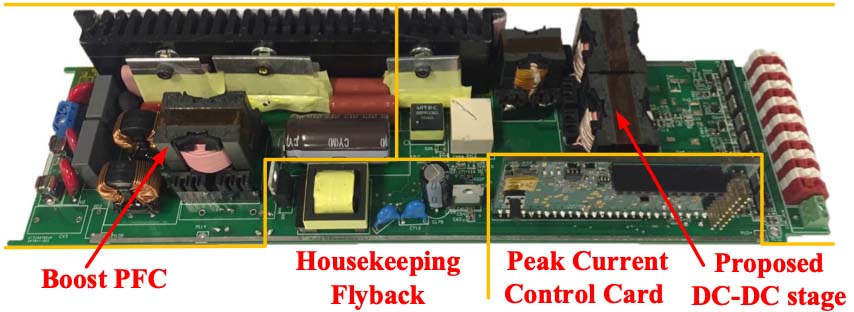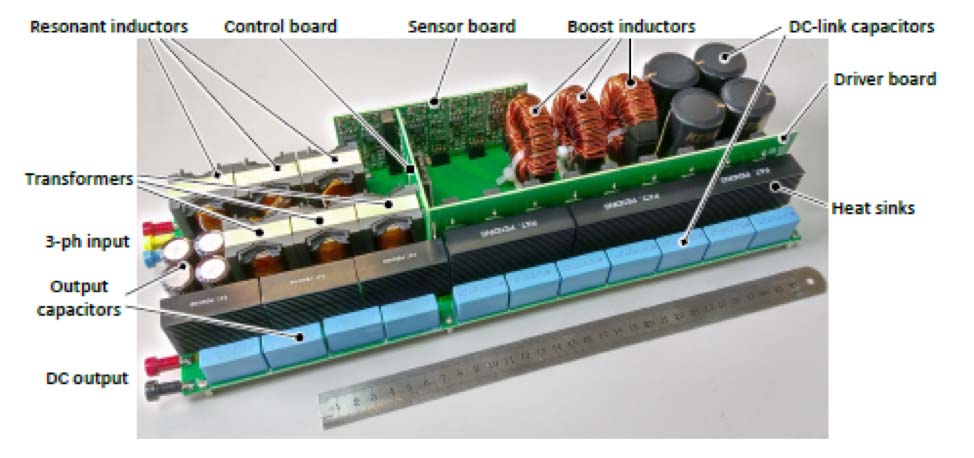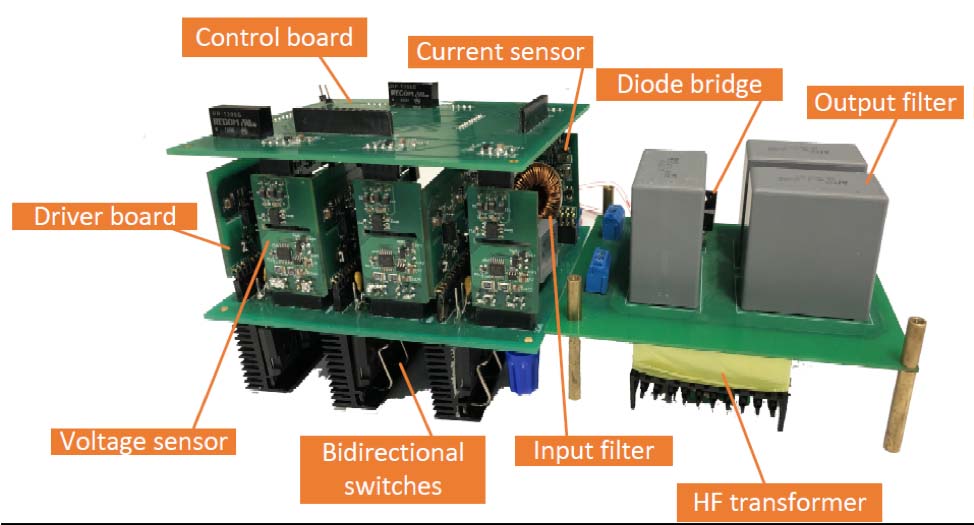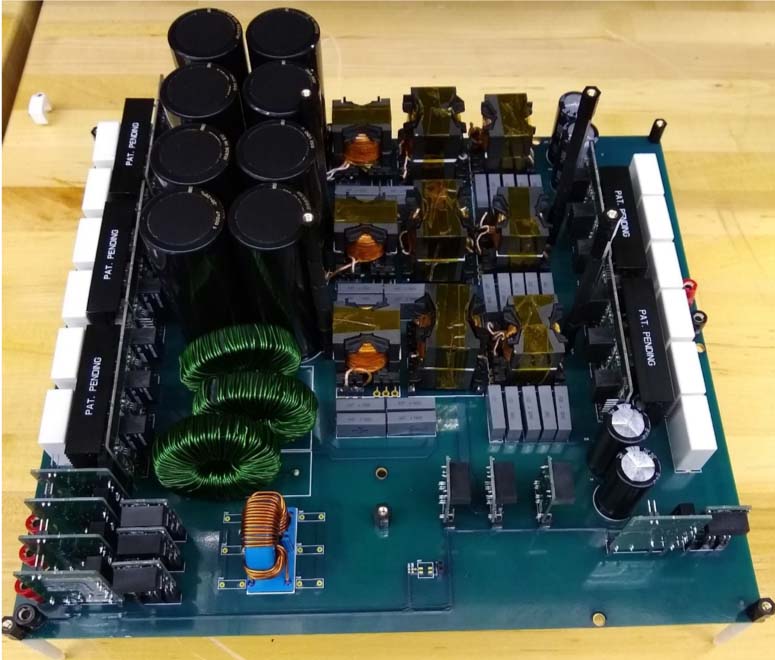Power Electronics Research Laboratory

Research Focus
Power Conversion Topologies
Wide-band gap power semiconductor devices have revolutionized power electronics. One of the major research focus of our group is on new multilevel and modular AC-DC and AC-AC power convertor topologies, which are only possible due to the existence of the wide-band gap (WBG) silicon carbide (SiC) devices. The new topologies are intended to have up to 25% lesser device count than the equivalent conventional multilevel converters.
Besides the reduction in device count, which potentially increases the reliability and reduces the cost by up to 30% of the power converter, the new converter topologies are intended to have full soft switching enabling energy efficient operation at high frequency, high voltage and high power.
Our research will result in higher power density of WBG-based power converters for high power and high voltage AC-DC and AC-AC power conversion, thus fully exploiting the capabilities of the WBG SiC devices to operate from high voltage and currents at high switching frequencies.
Applications of the new power converters are energy storage system to grid integration with fast dynamic response, on-board motor-drive/chargers for heavy electric vehicles, High-power density unified power flow controller for integrating renewable energy storage and battery energy storage to the grid, AC fast chargers for electric vehicles, etc.
Printable high-frequency magnetic components for high-frequency and high-power converters
Nano-crystalline magnetic materials are as promising as WBG devices for future power converters. These type of magnetic materials can potentially operate with high flux density than conventional ferrite material and can operate at significantly higher temperatures.
One of the drawbacks of this core material is the difficulty in manufacturing. Our research group is collaborating with Assistant Professor Scott N. Schiffres in Mechanical Engineering to explore ways of additive manufacturing of this core from its constituent elements to form planar magnetic cores with integrated magnetic components.
Some of the areas of additive manufacturing we are exploring are how thin the film of the nano-crystalline material can be formed in each layer, and how different non-magnetic substances can be interleaved with nanocrystalline material to form the core resulting in distributed gapped nano-crystalline cores with improved magnetic and thermal behavior.
Selectively dimmable multi-channel LED Drivers
LED luminaires typically consist of a matrix of LEDs where LED channels require equal currents to operate irrespective of fault or mutual mismatch. Existing single-channel drivers (SCD) and multiple high switching frequency stage multi-channel LED Drivers (MSMCD) both suffer from low efficiency ( about 90%), high cost and low lifetime (typically 50,000 hours compared to 90,000 to 100,000 hours for LEDs) due to their use of electrolytic capacitors (e-caps) to reduce light flicker.
Our research focus is on a family of fault-tolerant, cost-effective single high frequency stage multi-channel E-cap less LED drivers (SSMCD) with long lifetime (about 90,000 hours), highest-in-class efficiency (around 96%) and selective dimming by developing a new wide input front end AC-DC converter and high-efficiency multi-output DC-DC isolated converter each having 98% efficiency.
The result is a paradigm shift in the LED lighting industry, giving rise to centralized driver-based advanced energy efficient long lifetime almost zero downtime LED lighting system for commercial and terminal buildings, high bay, stadiums, urban lighting, indoor farming, etc.
These drivers control the PWM average current in each output channel and also the on-state current in the LED loads, thus controlling the on-state current density of the LED loads. This makes these driver specially attractive for organic LED (OLED) driving whose lifetime is sensitive to the on-state current density.
Control of Vanadium Redox Flow Battery
Our research interests on vanadium redox flow battery includes application to energy storage for electric vehicle fast-charging applications. We are researching in charging and discharging algorithms that minimizes impact on lifetime of such batteries during high charging and discharging rates. We are also researching sensorless control of redox flow batteries, optimization of round-trip efficiency and condition monitoring for fast-charging application of such batteries.
Current Funding Agencies
- National Science Foundation (CAREER Award)
- Department of Energy
- NYSERDA
- Semiconductor Research Corporation
- U.S. Air Force
- IEEC TAB Funding
Present Members
Current PhD Students
- Tuhin Sasmal: tsasmal1@binghamton.edu
- Srinivas Chappa: schappa@binghamton.edu
- Oscar Abundez Castrejon (co-supervised with Associate Professor Scott Schiffres): oabunde1@binghamton.edu
Current Master's Student
-
Sridharan Padmanabhan: spadman2@binghamton.edu
Past graduate students
- Bahman Khaki, PhD '21
- Kawsar Ali
- Sunil Dube, PhD '22 (received distinguished PhD dissertation award)
- Tyler Murray
Past Post-Doctoral Research Fellows
- Kalyan Yenduri (PhD, IIT Kanpur, India): kyenduri@binghamton.edu
- Ramu Nair (PhD, IISc, India): rnair@binghamton.edu
Converter prototypes developed by the research group

Prototype of highest in-class efficient two-stage multi-channel selective dimmable 150 W LED driver.

Prototype of 5 kW Three Phase AC to 380 V DC 96% efficient Single-Stage Converter based on SiC devices

Prototype of 1.5 kW Three-Phase 230 V AC to 270 V DC 94% efficient Single-Stage Electrolytic Capacitorless Matrix Converter based on SiC devices
